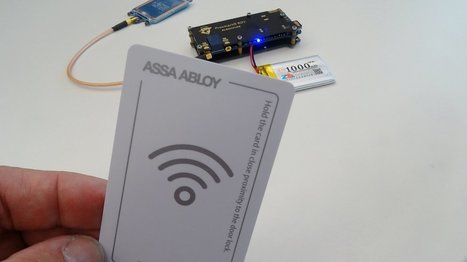 Your new post is loading...
 Your new post is loading...

|
Scooped by
Gust MEES
|
Three quarters of mobile applications have vulnerabilities relating to insecure data storage, leaving both Android and Apple iOS users open to cyber attacks which could allow hackers to steal sensitive information.
Insecure data storage is just one of a number of vulnerabilities which a security company's researchers said they have found after conducting security assessments of a number of mobile applications for both iPhones and and Google Android devices.
The findings have been outlined in the Vulnerabilities and Threats in Mobile Applications 2019 report from Positive Technologies.
Insecure data storage is by far the most common vulnerability identified in the tested applications, with 76 percent of those examined found to demonstrate this as a security risk, potentially putting the privacy and security of users at risk.
Just over a third of applications (35 percent) have been found to exhibit vulnerabilities relating to insecure transmission of sensitive data, while researchers found that the same percentage demonstrated issues around incorrect implementation of session expiration. Learn more / En savoir plus / Mehr erfahren: https://gustmees.wordpress.com/2014/03/05/often-asked-questions-are-there-cyber-security-dangers-with-apps-and-whats-about-privacy/ https://www.scoop.it/topic/securite-pc-et-internet/?&tag=Apps

|
Scooped by
Gust MEES
|
Fortwährende Bedrohung durch mobile und IoT-Malware
Malware wirkt sich nicht nur auf die Infrastruktur des Unternehmens aus, da die Bedrohung durch mobile Malware zunimmt. Angesichts der Zunahme bösartiger Android-Apps hat 2018 ein verstärkter Fokus auf Malware gelegen, die auf Telefone, Tablets und andere IoT-Geräte übertragen wurde. Da Privathaushalte und Unternehmen immer mehr internetgebundene Geräte verwenden, haben Kriminelle neue Wege gefunden, um diese Geräte als Knotenpunkte bei großen Botnetzangriffen zu verwenden. Im Jahr 2018 demonstrierte VPNFilter die zerstörerische Wirkung von Malware-Waffen, die eingebettete Systeme und Netzwerkgeräte betrafen, die keine offensichtliche Benutzeroberfläche haben. Mirai Aidra, Wifatch und Gafgyt lieferten außerdem eine Reihe automatisierter Angriffe, die vernetzte Geräte als Knoten in Botnetzen für verteilte Denial-of-Service-Angriffe, Mining-Kryptowährung und Infiltrationsnetzwerke nutzten.
Weitere und detaillierte Informationen zu Bedrohungstrends und zum Verhalten von Cyberkriminellen finden Sie im vollständigen Threat-Bericht der SophosLabs 2019 unter www.sophos.de/threatreport
Bei der Abwehr von Cyber-Angriffen wird man auch in Zukunft immer wieder vor Überraschungen stehen. Cyber-Kriminalität ist heute nicht nur ein lukratives Geschäft, sondern besticht auch zunehmend durch sehr gutes Design und hohe Intelligenz. Doch auch die Security-Branche entwickelt sich schnell. Beispielsweise durch Machine Learning, verhaltensbasierte Erkennung und die intelligente Vernetzung der Security, kann Sophos eine Vielzahl an modernen und hoch entwickelten Angriffen erkennen und abwehren. Die Security entwickelt sich rasch und ist in vielen Fällen bereits den Cyber-Kriminellen mindestens einen Schritt voraus.
Learn more / En savoir plus / Mehr erfahren: https://www.scoop.it/t/securite-pc-et-internet

|
Scooped by
Gust MEES
|
Eine Sicherheitslücke in WhatsApp ermöglicht es, ein Smartphone mit einem einzigen Video-Call zu kapern. Potentiell betroffen sind Milliarden WhatsApp-Nutzer.
Mit einem einzigen Videoanruf könnte ein Angreifer eine Sicherheitslücke ausnutzen, die im Code des Messengers WhatsApp schlummerte. Googles Project Zero, ein Team von Elite-Hackern hat diesen Fehler entdeckt und jetzt veröffentlicht – eine Woche nachdem WhatsApp eine fehlerbereinigte iOS-Version bereit gestellt hatte. Das fällige Android-Update gibt es bereits seit 28. September.
Der Fehler steckt in der Speicherverwaltung des Video-Conferencings. Ein speziell präpariertes RTP-Paket kann die so durcheinanderbringen, dass der Absender eigenen Code einschleusen und damit das Smartphone kapern kann. Natali Silvanovich vom Project Zero hat den Fehler entdeckt und dokumentiert ihn mit einem Beispiel-Exploit, der WhatsApp kontrolliert zum Absturz bringen kann. Das ist die gängige Methode, Fehler der allerobersten Kategorie zu demonstrieren. Learn more / En savoir plus / Mehr erfahren: http://www.scoop.it/t/securite-pc-et-internet/?&tag=WhatsApp..

|
Scooped by
Gust MEES
|
In den ersten beiden Artikeln unserer Reihe zur Malware-Entfernung haben wir uns bereits damit befasst, wie Sie unbekannte Malware sowie potenziell unerwünschte Programme (PUPs) erkennen und entfernen können. Heute werden wir uns mit einer Malware befassen, die in den vergangenen Jahren einen regelrechten Boom erlebt hat: Ransomware. Learn more / En savoir plus / Mehr erfahren: https://www.scoop.it/t/securite-pc-et-internet/?&tag=RANSOMWARE

|
Scooped by
Gust MEES
|
So praktisch SaaS ist. Das Konzept birgt auch große Risiken, wenn wie jetzt etwa Typeform ein SaaS-Provider das Opfer eines Datendiebstahls wird. Dann sind meist auch die Kunden des Anbieters betroffen.
Viele Unternehmen binden heutzutage immer wieder diverse Online-Umfragen in ihre Web-Seiten ein. Dabei greifen sie gerne auf vorgenerierte Formulare von externen Anbietern zu. Eines dieser Unternehmen, der spanische Software-as-a-Service-Spezialist (SaaS) Typeform, musste nun einen Datendiebstahl eingestehen, bei dem auch zahlreiche Datensätze von Kunden des Unternehmens geklaut worden sein sollen.
Der oder die Angreifer konnten sich laut Typeform Zugriff auf ein Backup von Anfang Mai dieses Jahres verschaffen. Darin enthalten waren API-Keys, Token zum Zugriff auf die von Typeform angebotenen Dienste und Zugangsdaten zu OAuth-Applikationen, aber auch Daten von Kunden, die Online-Formulare ausgefüllt hatten. Um welche Informationen es sich dabei genau handelte, teilte Typeform nicht mit. Laut Medienberichten meldeten sich aber bereits mehrere betroffene Unternehmen wie Fortnum & Mason.
Wie das Londoner Kaufhaus mitteilte, wurden ihm etwa 23.000 Datensätze gestohlen. Sie enthielten E-Mail-Adressen, Antworten auf Fragen und teilweise auch Postadressen sowie andere private Informationen der Nutzer. Learn more / En savoir plus / Mehr erfahren: https://www.scoop.it/t/securite-pc-et-internet/?&tag=DATA-BREACHES

|
Scooped by
Gust MEES
|
Sportswear maker Adidas announced a data breach yesterday evening, which the company says it impacted shoppers who used its US website.
The company says it became aware of the breach on Tuesday, June 26, when it learned that an unauthorized party was claiming to have acquired the details of Adidas customers.
"According to the preliminary investigation, the limited data includes contact information, usernames and encrypted passwords," an Adidas spokesperson said.
"Adidas has no reason to believe that any credit card or fitness information of those consumers was impacted," he added.
The company said it's still investigating the breach with law enforcement and security firms.
A few millions impacted Learn more / En savoir plus / Mehr erfahren: https://www.scoop.it/t/securite-pc-et-internet/?&tag=DATA-BREACHES https://www.scoop.it/t/securite-pc-et-internet/?&tag=wearables

|
Scooped by
Gust MEES
|
Android Google Playstore Trickbetrüger versuchen mit gefälschten Installationszahlen unwissende Smartphone User dazu zu animieren, fragwürdige Apps zu installieren. Wir zeigen, wie man den Schwindel aufdeckt. Learn more / En savoir plus / Mehr erfahren: https://www.scoop.it/t/securite-pc-et-internet/?&tag=Android

|
Scooped by
Gust MEES
|
MyHeritage, an Israeli DNA, and genealogy website has suffered a massive data breach in which email accounts and hashed passwords of 92 million users (92,283,889) who signed up to the service up to October 26, 2017, have been stolen.
The compromised MyHeritage data was discovered by a security researcher on a private server outside of MyHeritage and reported the incident to the company who after an in-depth analysis acknowledged the breach and published an official statement on June 4, 2018. Learn more / En savoir plus / Mehr erfahren: https://www.scoop.it/t/securite-pc-et-internet/?&tag=Cyber-Attacks

|
Scooped by
Gust MEES
|
The US Food and Drug Administration (FDA) last month approved a firmware patch for pacemakers made by Abbott’s (formerly St Jude Medical) that are vulnerable to cybersecurity attacks and which are at risk of sudden battery loss.
Some 465,000 patients are affected. The FDA is recommending that all eligible patients get the firmware update “at their next regularly scheduled visit or when appropriate depending on the preferences of the patient and physician. At the time, cryptographic expert Matthew Green, an assistant professor at John Hopkins University, described the pacemaker vulnerability scenario as the fuel of nightmares. Learn more / En savoir plus / Mehr erfahren: https://www.scoop.it/t/securite-pc-et-internet/?&tag=Pacemakers+Hacking

|
Scooped by
Gust MEES
|
Unser Tipp zum Welt-Passwort-Tag! Virenscanner, Firewall, getrennte Benutzerkonten und Verschlüsselung, Windows ist mit vielen Security-Tools bereits ausgestattet. Was fehlt ist eine Lösung für sichere Passwörter.
Mit Passwörtern ist es so eine Sache. Wir müssen uns zu viele von ihnen merken, was in den meisten Fällen dazu führt, dass man entweder verschiedene einfache Passwörter verwendet oder sich auf wenige sehr sichere konzentriert. Beide Strategien bergen ein hohes Risiko. Besser ist es, jedem Benutzerkonto ein eigenes sehr sicheres Passwort zu spendieren. Dafür braucht es aber eine Merkhilfe.
Natürlich können Sie auch Ihrem Browser Passwörter anvertrauen, wir raten aber zu einem anderen Ansatz. Tools wie KeePass packen Passwörter in eine verschlüssette Datei und versiegeln den Zugriff mit einem Masterpasswort. Sie müssen sich selbst also nur noch ein starkes Passwort merken.
Mit dem Entschlüsseln Sie Ihre Passwort-Datenbank und holen sich daraus die Passwörter für sämtliche Internet-Dienste. Der große Vorteil: So können Sie für jeden Dienst ein eigenes, sehr sicheres Passwort verwenden.
Sie geben die Passwörter auch nicht aus der Hand, wie bei LastPass & Co. Stattdessen haben nur Sie die Kontrolle über Ihre Passwörter.
Learn more / En savoir plus / Mehr erfahren: https://www.scoop.it/t/securite-pc-et-internet?page=2&tag=Passwords https://www.scoop.it/t/securite-pc-et-internet/?&tag=Password+Managers

|
Scooped by
Gust MEES
|
VW bugs: "Unpatchable" remote code pwnage
Two security researchers have excoriated Volkswagen Group for selling insecure cars. As in: hackable-over-the-internet insecure.
They broke into a recent-model VW and an Audi, via the cars’ internet connections, and were able to jump from system to system, running arbitrary code. Worryingly, they fully pwned the unauthenticated control bus connected to some safety-critical systems—such as the cruise control.
But VW has no way to push updates to its cars, and won’t alert owners to visit a dealer for an update.
Yes, it’s the internet of **** again: Potentially safety-critical bugs caused by the conflict between convenience and security. In this week’s Security Blogwatch, we prefer classic, analog vehicles.
Your humble blogwatcher curated these bloggy bits for your entertainment. Not to mention: Globfinity War…
Learn more / En savoir plus / Mehr erfahren: https://www.scoop.it/t/securite-pc-et-internet/?&tag=Cars https://www.scoop.it/t/securite-pc-et-internet/?&tag=iot

|
Scooped by
Gust MEES
|
Selon Threat Post, deux chercheurs en sécurité de l'entreprise hollandaise Computest, Daan Keuper et Thijs Alkemade, ont découvert des vulnérabilités dans le logiciel embarqué de la Volkswagen Golf GTE et de l'Audi3 Sportback e-tron
Ces vulnérabilités offrent pas mal d'amusements aux pirates : ouvrir le microphone pour écouter les conversation à l'intérieur du véhicule, accéder au carnet d'adresses complet, à l'historique des conversations, tracer le véhicule à travers son système de navigation, modifier l'affichage de l'écran du système..
Ce n'est pas tout... Poussant leurs investigations, les chercheurs ont constaté qu'il est possible de lire n'importe quel fichier sur le disque du système et même d'exécuter du code arbitraire à distance.
Volswagen commente l'affaire ainsi auprès de Threatpost : "Nous sommes en contact avec Computest depuis la mi-2017", la correction de bugs - en d'autres termes, l'élimination de la vulnérabilité - avait déjà eu lieu début mai 2016."
Fort bien... Toutefois en ce qui concerne les corrections des bugs, les chercheurs sont beaucoup plus nuancés : "Le système que nous avons étudié ne peut pas être mis à jour par l'utilisateur final, un utilisateur doit se rendre chez un revendeur officiel pour recevoir une mise à jour. Cependant, d'après notre expérience, il semble que les voitures qui ont été produites auparavant ne sont pas automatiquement mises à jour lorsqu'elles sont réparées chez un concessionnaire, elles sont donc toujours vulnérables à l'attaque décrite. Learn more / En savoir plus / Mehr erfahren: https://www.scoop.it/t/securite-pc-et-internet/?&tag=Cars https://www.scoop.it/t/securite-pc-et-internet/?&tag=iot

|
Scooped by
Gust MEES
|
Die Schlösser von Millionen Hotelzimmern können Recherchen zufolge geknackt werden. Finnische IT-Experten fanden heraus, dass dazu eine einzige Hotelkarte ausreicht.
26. April 2018, 2:18 Uhr Quelle: ZEIT ONLINE, dpa, Reuters, ces
IT-Experte Timo Hirvonen hat das Rätsel um den Diebstahl eines Computers aus einem Hotelzimmer gelöst: diese Chipkarten. © Attila Cser/Reuters
Die elektronischen Schlösser in mehr als einer Million Hotelzimmertüren auf der ganzen Welt sind finnischen Sicherheitsexperten zufolge selbst mit alten Zugangskarten zu knacken. Zwei Mitarbeiter des Sicherheitsunternehmens F-Secure haben am Mittwoch eine Untersuchung zu der Schwachstelle veröffentlicht und damit wohl auch das Rätsel eines Laptop-Diebstahls 2003 in Berlin gelöst. Betroffen sind die Schlösser des Weltmarktführers Assa Abloy, eines schwedischen Unternehmens.
Timo Hirvonen und Tomi Tuominen zeigten Reportern von WDR, NDR und Süddeutscher Zeitung, wie der Einbruch ins Hotelzimmer gelingen kann, ohne Spuren zu hinterlassen. Lediglich eine einzige Hotelkarte reichte aus, um einen Generalschlüssel zu erstellen und damit alle Gästezimmer des jeweiligen Hotels zu öffnen. Der Vorgang dauert nur ein paar Sekunden. Darüber hinaus gelang es den IT-Experten über das Netzwerk der betroffenen Hotels auch Kundendaten auszulesen. Die beiden Finnen hatten sich zunächst in ihrer Freizeit damit beschäftigt, den ungeklärten Laptop-Diebstahl aufzuklären. Learn more / En savoir plus / Mehr erfahren: https://www.scoop.it/t/securite-pc-et-internet/?&tag=Traveling
|

|
Scooped by
Gust MEES
|
Malware targeting Linux users may not be as widespread as the strains targeting the Windows ecosystem, but Linux malware is becoming just as complex and multi-functional as time passes by.
The latest example of this trend is a new trojan discovered this month by Russian antivirus maker Dr.Web. This new malware strain doesn't have a distinctive name, yet, being only tracked under its generic detection name of Linux.BtcMine.174.
The trojan itself is a giant shell script of over 1,000 lines of code. This script is the first file executed on an infected Linux system. The first thing this script does is to find a folder on disk to which it has write permissions so it can copy itself and later use to download other modules.
Once the trojan has a foothold on the system it uses one of two privilege escalation exploits CVE-2016-5195 (also known as Dirty COW) and CVE-2013-2094 to get root permissions and have full access to the OS. Learn more / En savoir plus / Mehr erfahren: https://www.scoop.it/t/securite-pc-et-internet/?&tag=Linux

|
Scooped by
Gust MEES
|
Hacker haben Tausende sensible Dateien von den Servern eines französischen Konzerns gestohlen. Das Unternehmen ist auch am Bau von Atomanlagen und Gefängnissen beteiligt
Bei einem Angriff auf ein französisches Bauunternehmen konnten Hacker zahlreiche Dokumente zu kritischer Infrastruktur wie Atomkraftwerken, Gefängnissen und Straßenbahnnetzen erbeuten. Der Konzern Ingérop, der seinen Hauptsitz nahe Paris hat und weltweit an großen Bauprojekten beteiligt ist, bestätigte den Angriff auf Anfrage.
Der dabei kopierte Datensatz, der dem NDR vorliegt und den Reporter gemeinsam mit der "Süddeutschen Zeitung" und "Le Monde" ausgewertet haben, umfasst mehr als 65 Gigabyte. Darunter sind Pläne der Standorte von Videokameras, die in einem französischen Hochsicherheitsgefängnis eingesetzt werden sollten, Unterlagen zu einem geplanten Atommüll-Endlager im Nordosten Frankreichs und persönliche Informationen zu mehr als 1200 Ingérop-Mitarbeiterinnen und Mitarbeitern. Auch einige firmeninterne E-Mails sind Teil des Datenlecks. Learn more / En savoir plus / Mehr erfahren: https://www.scoop.it/t/securite-pc-et-internet/?&tag=DATA-BREACHES https://www.scoop.it/t/securite-pc-et-internet/?&tag=AKW

|
Scooped by
Gust MEES
|
Wenn Apps auf Speicherkarten zugreifen, kann dies von Cyberkriminellen ausgenutzt werden. Mit der sogenannten Man-in-the-Disk-Attacke können sie den Datenstrom manipulieren.
Ein "Man-in-the-Disk-Angriff" läuft in mehreren Schritten ab.
(Quelle: Check Point ) Die Verwendung von Speicherkarten durch Apps kann von Cyberkriminellen ausgenutzt werden, um Android-Smartphones anzugreifen. Zu diesem Schluss kommt ein Bericht der Sicherheitsspezialisten von Check Point. Die sogenannte Man-in-the-Disk-Attacke erlaubt es einem Angreifer, in den externen Speicher – beispielsweise eine Speicherkarte – einzudringen und sich einzumischen.
Der interne Speicher der Smartphones wird durch die Android-Sandbox abgeschirmt. Der Schutz für externe Speichermedien ist geringer. Dies erlaube dem Angreifer, den Datenaustausch zwischen der App und dem externen Speicher abzufangen und zu manipulieren. Beispielsweise kann er unerwünschte Anwendungen im Hintergrund installieren, Apps zum Absturz bringen oder Schadcode in Apps einschleusen.
Neben Androids Umgang mit Speicherkarten liegt das Problem auch bei den Entwicklern, die sich mit ihren Apps nicht an Googles Richtlinien zur Nutzung externer Speichermedien halten. Unter den von Check Point geprüften Apps waren allerdings auch Apps, die von Google selbst stammen. Darunter waren Google Translate, Google Voice Typing und Google Text-to-Speech.
Beispielsweise im Falle von Google Translate und Google Voice Typing haben die Sicherheitsexperten festgestellt, dass die Entwickler die Integrität der aus dem externen Speicher gelesenen Daten nicht überprüfen konnten. So war das Team in der Lage, bestimmte Dateien, die von diesen Anwendungen benötigt werden, zu kompromittieren. Dies führte zum Absturz der Anwendungen.
Learn more / En savoir plus / Mehr erfahren: https://www.scoop.it/t/securite-pc-et-internet/?&tag=Android

|
Scooped by
Gust MEES
|
Another day, another Linux community with malware woes.
Last time it was Gentoo, a hard-core, source-based Linux distribution that is popular with techies who like to spend hours tweaking their entire operating sytem and rebuilding all their software from scratch to wring a few percentage points of performance out of it.
That sort of thing isn’t for everyone, but it’s harmless fun and it does give you loads of insight into how everything fits together.
That sets it apart from distros such as ElementaryOS and Mint, which rival and even exceed Windows and macOS for ease of installation and use, but don’t leave you with much of a sense of how it all actually works.
This time, the malware poisoning happened to Arch Linux, another distro we’d characterise as hard-core, though very much more widely used than Gentoo.
Three downloadable software packages in the AUR, short for Arch User Respository, were found to have been rebuilt so they contained what you might (perhaps slightly unkindly) refer to as zombie downloader robot overlord malware.
Bots or zombies are malware programs that call home to fetch instructions from the crooks on what to do next.

|
Scooped by
Gust MEES
|
Data breaches are always bad news, and this one is peculiarly bad.
Gentoo, a popular distribution of Linux, has had its GitHub repository hacked.
Hacked, as in “totally pwned”, taken over, and modified; so far, no one seems to be sure quite how or why.
That’s the bad news.
Fortunately (we like to find silver linings here at Naked Security):
The Gentoo team didn’t beat around the bush, and quickly published an unequivocal statement about the breach.
The Gentoo GitHub repository is only a secondary copy of the main Gentoo source code.
The main Gentoo repository is intact.
All changes in the main Gentoo repository are digitally signed and can therefore be verified.
As far as we know, the main Gentoo signing key is safe, so the digital signatures are reliable.
Learn more / En savoir plus / Mehr erfahren: https://www.scoop.it/t/securite-pc-et-internet/?&tag=Linux

|
Scooped by
Gust MEES
|
Hacker erlangen Zugriff auf Gentoo-Code in Github
Der Quellcode der Linux-Distribution Gentoo könnte kompromittiert sein: Das Entwicklerteam berichtet von einem Hack der gesamten Github-Organisation, in der Repositories abgelegt sind. Davon unberührt sein sollen die Backup-Dateien, die das Team auf eigener Infrastruktur hostet. Learn more / En savoir plus / Mehr erfahren: https://www.scoop.it/t/securite-pc-et-internet/?&tag=Linux

|
Scooped by
Gust MEES
|
The latest Facebook privacy SNAFU (Situation Normal, All Facebooked Up) is a bug that changed settings on some accounts, automatically suggesting that their updates be posted publicly, even though users had previously set their updates as “private”.
On Thursday, Facebook asked 14 million users to review posts made between 18 May and 22 May: that’s when the bug was changing account settings. Not all of the 14 million users affected by the bug necessarily had their information publicly, mistakenly shared, but best to check.
Facebook Chief Privacy Officer Erin Egan said in a post that as of Thursday, the company had started letting those 14 million people know about the situation. She stressed that the bug didn’t affect anything people had posted before that time, and even then, they could still have chosen their audience like they always have.
Normally, the audience selector is supposed to be sticky: every time you share something, you get to choose who sees it, and the suggestion is supposed to be based on who you shared stuff with the last time you posted. Friends only? Fine, that’s what should be automatically suggested for the next post, and the one after that, until you change it… or a weird little glitch like this pops up. Learn more / En savoir plus / Mehr erfahren: https://www.scoop.it/t/securite-pc-et-internet/?&tag=Facebook

|
Scooped by
Gust MEES
|
A company that collects the real-time location data on millions of cell phone customers across North America had a bug in its website that allowed anyone to see where a person is located -- without obtaining their consent.
US cell carriers are selling access to your real-time phone location data
The company embroiled in a privacy row has "direct connections" to all major US wireless carriers, including AT&T, Verizon, T-Mobile, and Sprint -- and Canadian cell networks, too.
Earlier this week, we reported that four of the largest cell giants in the US are selling your real-time location data to a company that you've probably never heard about before.
The company, LocationSmart, is a data aggregator and claims to have "direct connections" to cell carriers to obtain locations from nearby cell towers. The site had its own "try-before-you-buy" page that lets you test the accuracy of its data. The page required explicit consent from the user before their location data can be used by sending a one-time text message to the user. When we tried with a colleague, we tracked his phone to a city block of his actual location.
But that website had a bug that allowed anyone to track someone's location silently without their permission.
"Due to a very elementary bug in the website, you can just skip that consent part and go straight to the location," said Robert Xiao, a PhD student at the Human-Computer Interaction Institute at Carnegie Mellon University, in a phone call.
"The implication of this is that LocationSmart never required consent in the first place," he said. "There seems to be no security oversight here."
The "try" website was pulled offline after Xiao privately disclosed the bug to the company, with help from CERT, a public vulnerability database, also at Carnegie Mellon.
Xiao said the bug may have exposed nearly every cell phone customer in the US and Canada, some 200 million customers. Learn more / En savoir plus / Mehr erfahren: https://gustmees.wordpress.com/2013/12/21/privacy-in-the-digital-world-shouldnt-we-talk-about-it/ https://www.scoop.it/t/securite-pc-et-internet/?&tag=tracking https://www.scoop.it/t/securite-pc-et-internet/?&tag=Privacy https://www.scoop.it/t/securite-pc-et-internet/?&tag=Big+Data

|
Scooped by
Gust MEES
|
Twitter has admitted that user passwords were briefly stored in plaintext and may have been exposed to the company's internal tools.
In a blog post, the microblogging site urged users to change their passwords.
"When you set a password for your Twitter account, we use technology that masks it so no one at the company can see it. We recently identified a bug that stored passwords unmasked in an internal log," said Twitter in a statement.
Twitter didn't say how many accounts were affected, but Reuters reports -- citing a source -- that the number of affected users was "substantial" and that passwords were exposed for "several months."
It's unclear exactly why user passwords were stored in plaintext before they were hashed. Twitter said that it stores user passwords with bcrypt, a stronger password hashing algorithm, but a bug meant that passwords were "written to an internal log before completing the hashing process."
The company said it fixed the bug and that an investigation "shows no indication of breach or misuse" by anyone.
A spokesperson for Twitter reiterated that the bug "is related to our internal systems only," but it did not comment further.
"Since this is not a breach and our investigation has shown no signs of misuse, we are not forcing a password reset but are presenting the information for people to make an informed decision about their account," said the spokesperson. "We believe this is the right thing to do."
The company had 330 million users at its fourth-quarter earnings in February.
Read also: Twitter hopes trolls can be stopped by eradicating ignorance
Twitter is the second company to admit a password-related bug this week.
GitHub on Tuesday said it also exposed some users' plaintext passwords after they were written to an internal logging system.
It's not known if the two incidents are related, and a Twitter spokesperson would not comment in a follow-up email. Learn more / En savoir plus / Mehr erfahren: https://www.scoop.it/t/securite-pc-et-internet?page=2&tag=Passwords https://www.scoop.it/t/securite-pc-et-internet/?&tag=Password+Managers https://www.scoop.it/t/securite-pc-et-internet/?&tag=Twitter

|
Scooped by
Gust MEES
|
Heute feiert das Netz den Tag des Passworts. Wir haben dies zum Anlass genommen, Ihnen acht Tipps für den sicheren Umgang mit Passwörtern und anderen Sicherheitsvorkehrungen zu geben. Und einigen von Ihnen den Spiegel vorzuhalten. Learn more / En savoir plus / Mehr erfahren: https://www.scoop.it/t/securite-pc-et-internet?page=2&tag=Passwords

|
Scooped by
Gust MEES
|
Vulnerable in-vehicle infotainment systems have left some Volkswagen cars open to remote hacking, researchers warn. Over the last few years, automakers like Ford, Jeep, Nissan and Toyota have all suffered car-hacking vulnerabilities in their vehicles. Now, it looks like Volkswagen has been pulled into the mix after researchers discovered that in-vehicle infotainment (IVI) systems in certain Volkswagen-manufactured cars could be remotely hacked. Not only that, but it’s possible to pivot to more critical systems. Related PostsApril 25, 2018 , 11:30 am April 25, 2018 , 9:30 am April 19, 2018 , 1:17 pm The vulnerability was discovered in the Volkswagen Golf GTE and an Audi3 Sportback e-tron, which were both manufactured in 2015. Computest researchers Daan Keuper and Thijs Alkemade, who discovered the flaw, said that under certain conditions the IVI vulnerability could enable attackers to commandeer the on-board microphone to listen in on the conversations of the driver, turn the microphone on and off, and access the system’s complete address book and the conversation history. There is also a possibility of hackers tracking the car through the navigation system at any given time, they said. A Volkswagen spokesperson told Threatpost that the vehicles impacted are those produced with Discover Pro infotainment systems – Golf GTE and Audi A3 e-tron. Learn more / En savoir plus / Mehr erfahren: https://www.scoop.it/t/securite-pc-et-internet/?&tag=Cars https://www.scoop.it/t/securite-pc-et-internet/?&tag=iot

|
Scooped by
Gust MEES
|
Over a million fiber routers can be remotely accessed, thanks to an authentication bypass bug that's easily exploited by modifying the URL in the browser's address bar.
The bug lets anyone bypass the router's login page and access pages within -- simply by adding "?images/" to the end of the web address on any of the router's configuration pages, giving an attacker near complete access to the router. Because the ping and traceroute commands on the device's diagnostic page are running at "root" level, other commands can be remotely run on the device, too.
The findings, published Monday, say the bug is found in routers used for fiber connections. These routers are central in bringing high-speed fiber internet to people's homes.
At the time of writing, about 1.06 million routers marked were listed on Shodan, the search engine for unprotected devices and databases. Half the vulnerable routers are located on the Telmex network in Mexico, and the rest are found on in Kazakhstan and Vietnam. Learn more / En savoir plus / Mehr erfahren: https://www.scoop.it/t/securite-pc-et-internet/?&tag=Router
|



 Your new post is loading...
Your new post is loading...




























Three quarters of mobile applications have vulnerabilities relating to insecure data storage, leaving both Android and Apple iOS users open to cyber attacks which could allow hackers to steal sensitive information.
Insecure data storage is just one of a number of vulnerabilities which a security company's researchers said they have found after conducting security assessments of a number of mobile applications for both iPhones and and Google Android devices.
The findings have been outlined in the Vulnerabilities and Threats in Mobile Applications 2019 report from Positive Technologies.
Insecure data storage is by far the most common vulnerability identified in the tested applications, with 76 percent of those examined found to demonstrate this as a security risk, potentially putting the privacy and security of users at risk.
Just over a third of applications (35 percent) have been found to exhibit vulnerabilities relating to insecure transmission of sensitive data, while researchers found that the same percentage demonstrated issues around incorrect implementation of session expiration.
Learn more / En savoir plus / Mehr erfahren:
https://gustmees.wordpress.com/2014/03/05/often-asked-questions-are-there-cyber-security-dangers-with-apps-and-whats-about-privacy/
https://www.scoop.it/topic/securite-pc-et-internet/?&tag=Apps